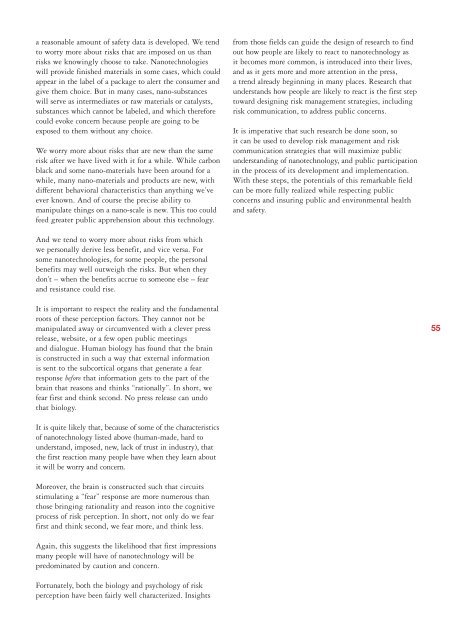Small size - large impact - Nanowerk
Small size - large impact - Nanowerk
Small size - large impact - Nanowerk
Create successful ePaper yourself
Turn your PDF publications into a flip-book with our unique Google optimized e-Paper software.
a reasonable amount of safety data is developed. We tend<br />
to worry more about risks that are imposed on us than<br />
risks we knowingly choose to take. Nanotechnologies<br />
will provide finished materials in some cases, which could<br />
appear in the label of a package to alert the consumer and<br />
give them choice. But in many cases, nano-substances<br />
will serve as intermediates or raw materials or catalysts,<br />
substances which cannot be labeled, and which therefore<br />
could evoke concern because people are going to be<br />
exposed to them without any choice.<br />
We worry more about risks that are new than the same<br />
risk after we have lived with it for a while. While carbon<br />
black and some nano-materials have been around for a<br />
while, many nano-materials and products are new, with<br />
different behavioral characteristics than anything we’ve<br />
ever known. And of course the precise ability to<br />
manipulate things on a nano-scale is new. This too could<br />
feed greater public apprehension about this technology.<br />
from those fields can guide the design of research to find<br />
out how people are likely to react to nanotechnology as<br />
it becomes more common, is introduced into their lives,<br />
and as it gets more and more attention in the press,<br />
a trend already beginning in many places. Research that<br />
understands how people are likely to react is the first step<br />
toward designing risk management strategies, including<br />
risk communication, to address public concerns.<br />
It is imperative that such research be done soon, so<br />
it can be used to develop risk management and risk<br />
communication strategies that will maximize public<br />
understanding of nanotechnology, and public participation<br />
in the process of its development and implementation.<br />
With these steps, the potentials of this remarkable field<br />
can be more fully realized while respecting public<br />
concerns and insuring public and environmental health<br />
and safety.<br />
And we tend to worry more about risks from which<br />
we personally derive less benefit, and vice versa. For<br />
some nanotechnologies, for some people, the personal<br />
benefits may well outweigh the risks. But when they<br />
don’t – when the benefits accrue to someone else – fear<br />
and resistance could rise.<br />
It is important to respect the reality and the fundamental<br />
roots of these perception factors. They cannot not be<br />
manipulated away or circumvented with a clever press<br />
release, website, or a few open public meetings<br />
and dialogue. Human biology has found that the brain<br />
is constructed in such a way that external information<br />
is sent to the subcortical organs that generate a fear<br />
response before that information gets to the part of the<br />
brain that reasons and thinks “rationally”. In short, we<br />
fear first and think second. No press release can undo<br />
that biology.<br />
55<br />
It is quite likely that, because of some of the characteristics<br />
of nanotechnology listed above (human-made, hard to<br />
understand, imposed, new, lack of trust in industry), that<br />
the first reaction many people have when they learn about<br />
it will be worry and concern.<br />
Moreover, the brain is constructed such that circuits<br />
stimulating a “fear” response are more numerous than<br />
those bringing rationality and reason into the cognitive<br />
process of risk perception. In short, not only do we fear<br />
first and think second, we fear more, and think less.<br />
Again, this suggests the likelihood that first impressions<br />
many people will have of nanotechnology will be<br />
predominated by caution and concern.<br />
Fortunately, both the biology and psychology of risk<br />
perception have been fairly well characterized. Insights
















